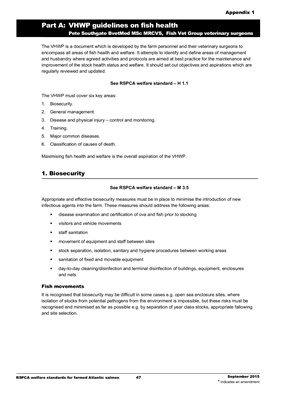
Appendix 1
RSPCA welfare standards for farmed Atlantic salmon 47 September 2015
* indicates an amendment
Part A: VHWP guidelines on fish health
Pete Southgate BvetMed MSc MRCVS, Fish Vet Group veterinary surgeons
The VHWP is a document which is developed by the farm personnel and their veterinary surgeons to
encompass all areas of fish health and welfare. It attempts to identify and define areas of management
and husbandry where agreed activities and protocols are aimed at best practice for the maintenance and
improvement of the stock health status and welfare. It should set out objectives and aspirations which are
regularly reviewed and updated.
See RSPCA welfare standard - H 1.1
The VHWP must cover six key areas:
1. Biosecurity.
2. General management.
3. Disease and physical injury - control and monitoring.
4. Training.
5. Major common diseases.
6. Classification of causes of death.
Maximising fish health and welfare is the overall aspiration of the VHWP.
1. Biosecurity
See RSPCA welfare standard - M 3.5
Appropriate and effective biosecurity measures must be in place to minimise the introduction of new
infectious agents into the farm. These measures should address the following areas:
disease examination and certification of ova and fish prior to stocking
visitors and vehicle movements
staff sanitation
movement of equipment and staff between sites
stock separation, isolation, sanitary and hygiene procedures between working areas
sanitation of fixed and movable equipment
day-to-day cleaning/disinfection and terminal disinfection of buildings, equipment, enclosures
and nets.
Fish movements
It is recognised that biosecurity may be difficult in some cases e.g. open sea enclosure sites, where
isolation of stocks from potential pathogens from the environment is impossible, but these risks must be
recognised and minimised as far as possible e.g. by separation of year class stocks, appropriate fallowing
and site selection.